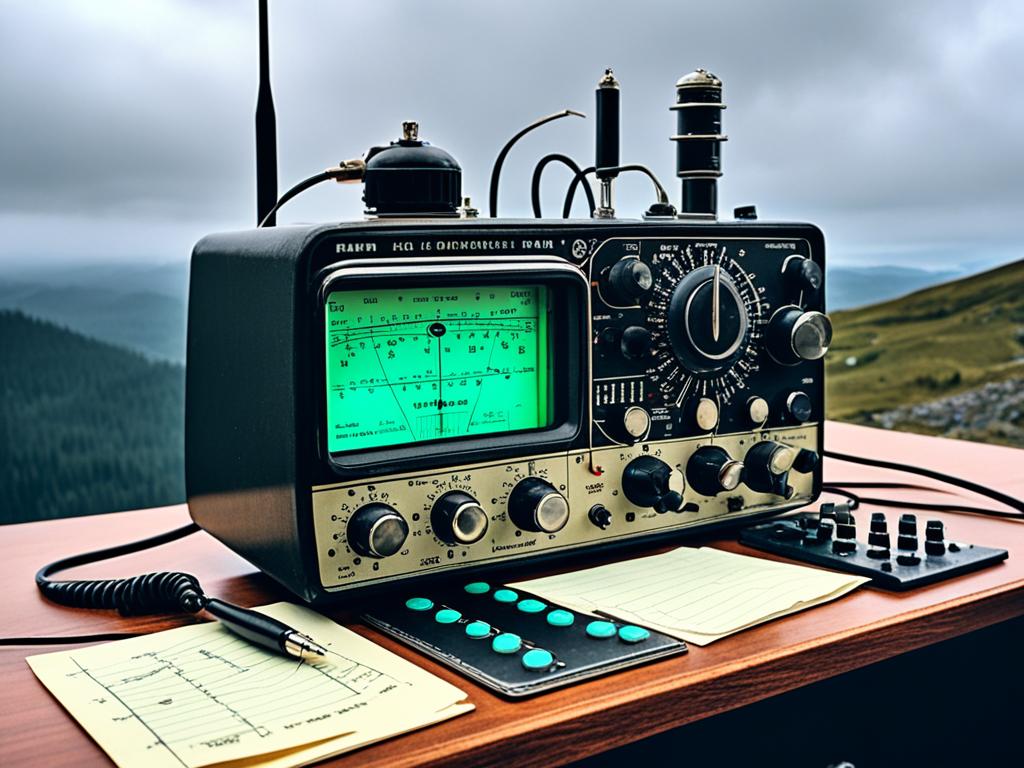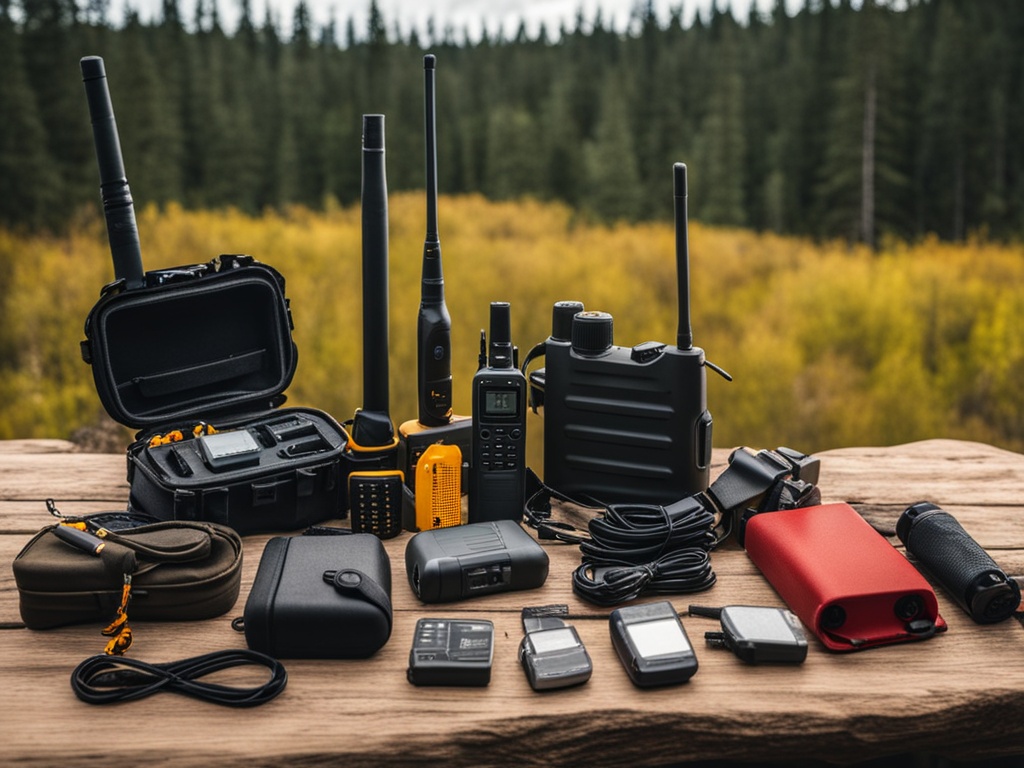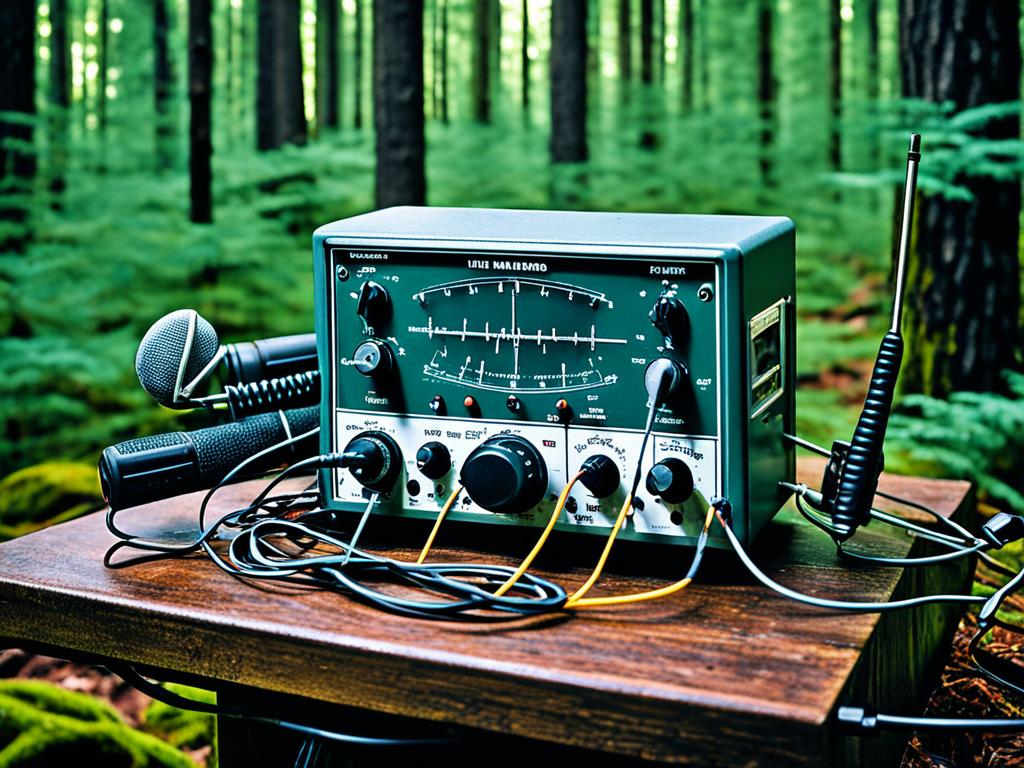During emergencies, good communication can save lives. If the usual ways of communication stop working, you need backup plans. This article looks at key methods for staying in touch, like ham radios and Morse code. By learning these skills, you’ll be ready for any crisis.
Key Takeaways
- Effective communication is vital for survival and emergency preparedness.
- Traditional communication methods may fail during a crisis, requiring alternative solutions.
- Ham radio, Morse code, signal mirrors, and smoke signals are essential communication tools for survival preppers.
- Mastering these communication techniques can improve one’s ability to respond to and navigate emergencies.
- Understanding the importance of communication in survival planning is crucial for being prepared for unexpected events.
Introduction to Survival Communication
Effective communication is key in emergencies and disasters. Traditional ways to communicate might not work then. So, it’s important for survival preppers to have other methods ready. This section will dive into the need for good communication when crisis hits. And, it will share top ways to keep in touch with family, responders, and important info.
Why Communication is Crucial in Emergencies
When a disaster happens, talking to others can save lives. It helps with rescue plans, finding family, or getting vital updates. Being able to share and get info can keep even the most prepared people safe. Learning about communication’s role in emergencies helps survival preppers. They can get the tools and know-how they need to not be cut off when it counts.
Overview of Essential Communication Methods
We’ll cover various methods for off-grid communication and disaster response. Key tools like ham radio, Morse code, and signal mirrors will be introduced. Readers will learn about the pros and cons of each tool. So, they can pick the best ones for their unique situation. Having a diverse set of communication tools is vital for anyone readying for a crisis or disaster.
Two-Way Radios and Ham Radio
In survival and emergencies, two-way radios and ham radio shine. They offer a stable way to talk when cell networks fail. This happens because ham radio uses its own frequencies, which work without the power grid.
Understanding Ham Radio Frequencies
The ham radio world is big. It covers many frequencies for different needs. For far-off talks, use the lower HF bands. For closer chats, the higher VHF and UHF bands work best. Knowing the right frequencies helps in ham radio use for disaster communication and off-grid communication needs.
Obtaining a Ham Radio License
You need a license to operate a ham radio. The FCC gives out these licenses in the U.S. To get one, you must pass a test. This shows you understand the rules and tech. Having a license means you can legally use ham radios. It helps keep emergency communication smooth and legal.
Setting up a Ham Radio Station
Creating a ham radio station takes planning. For disaster communication or off-grid communication, setting up right matters. Choose the proper equipment and place antennas well. Also, pick the best power options. This way, your station will keep working, even if the power goes out. Setting up carefully helps survivalists connect and help each other in times of crisis.

Satellite Phones and Emergency Beacons
Satellite phones and emergency beacons are now key in being ready for survival. They become crucial when usual ways of calling for help don’t work. As someone focused on being prepared, I’ve realized how much they help in staying safe and connected. This is especially true when the normal phone networks fail.
With satellite phones, you can speak to people and emergency services directly, without needing regular cell phone towers. This direct link is vital in distant areas away from society. These phones are tough and can save your life by letting you call for rescue. They also help keep in contact with friends and family wherever you go.
Emergency beacons are another must-have. They are small and send out a signal with your location when you’re in trouble. This signal is picked up by rescuers, telling them exactly where you are. By using both satellite phones and beacons, I boost my chances of quick help in emergencies.
As I learn more about satellite phones and emergency beacons, I understand both their strong points and limits. They have great reach and work well, but they can be expensive and require checking on their battery. It’s key to think about my own situation to pick the best options for talking in emergencies or off the grid.
| Feature | Satellite Phones | Emergency Beacons |
|---|---|---|
| Coverage | Global, independent of cellular networks | Worldwide, with GPS-enabled location tracking |
| Primary Function | Voice and data communication | Distress signal transmission and location sharing |
| Power Consumption | Relatively higher battery drain | Generally longer battery life |
| Durability | Designed for rugged environments | Highly durable and weatherproof |
| Cost | Generally more expensive upfront and ongoing | More affordable for basic models |
As I get better at surviving, satellite phones and emergency beacons have become crucial in my kit. Knowing what they can do, help make smart choices. This keeps me all set for handling any dangerous situation or natural disaster.
Means of communication: Survival, Prepping
Communication is key in any survival plan. When disaster hits and usual ways to talk are gone, having many ways to reach out could save lives. Knowing what tools work best and how to use them well is vital for preppers.
Advantages and Disadvantages of Different Prepping Communication Methods
Prepping has many communication gadgets, from radios to phones that work anywhere. It’s important to see what each tool can and can’t do. For example, ham radios can talk far without the need for usual phone lines. Yet, using them needs some training and a special license. On the other hand, satellite phones can call everywhere but need both money and a power source to run.
Even simple ways to signal, like smoke or a mirror, can help at times. But, they might not work well in all places or weather. Knowing about these options helps preppers choose what to have in their plans.
Integrating Communication into Your Survival Plan
The best communication strategy for prepping uses many different tools. This way, you can always find a way to talk, no matter what happens. Plan how to use all your gadgets to get help and stay in touch with loved ones during tough times.
First focus on setting up good ways to talk. This is key for being ready if something bad happens. Good communication might be what keeps you safe in an emergency, so it’s a must-have in your plans.

Smoke Signals and Signal Mirrors
In a world without today’s tech, old ways to communicate become very important. Things like smoke signals and using mirrors to reflect the sun’s light can help people survive. Smoke signals grab attention and convey messages. Signal mirrors, on the other hand, are great for asking for help. Let’s look at how to use these methods effectively, so you can be ready for anything.
Mastering Smoke Signal Techniques
To make strong smoke signals, you need to know the basics well. The goal is to make a thick, visible column of smoke. Use materials like wood or pine needles, even damp leaves will work. The way you build your fire matters too. Making a tepee shape keeps the smoke steady. Also, knowing which way the wind blows helps your signal be seen further.
Getting the timing right for your smoke signals is key. Practice making quick bursts of smoke and slow, steady signals too. This skill lets you share different messages or get noticed by others. Trying out different materials and methods helps you find what works best.
Using Signal Mirrors Effectively
Signal mirrors, or heliographs, are essential for prepping in case of disaster. They reflect sunlight in a flash that can be seen from far away. Learning how to point and focus the mirror is crucial. So is knowing the best time and way to signal.
Where you put the mirror and how you angle it greatly affect who sees your signal. Practice aiming the reflected light towards where help might be. And pick the best weather for your signal, like when the sky is clear. This makes your mirror message more likely to reach rescuers.
Morse Code and Semaphore Flags
In the world of off-the-grid communication and disaster readiness, two methods are especially important: Morse code and semaphore flags. They are simple but key for keeping in touch when tech fails.
Learning Morse Code
Morse code uses dots and dashes for messages. You can use it to talk over long distances, even without tech. Learning Morse lets survival experts stay in contact. They can use it with gadgets, radios, or lights in emergencies.
Semaphore Flag Communication Basics
Semaphore flags give a way to talk nearby without speaking. You just need two flags. By moving them in different ways, you can send messages. This is handy for getting help or working with people close by in a disaster. Knowing how to use these flags well is great for anyone ready for hard times.
Morse code and semaphore flags are very important in tough times or emergencies. Learning them is wise. This way, those preparing for disasters have good ways to communicate, no matter what happens.
Off-Grid Communication Alternatives
Sometimes, the best ways to talk are out of reach. When normal ways to connect are down, it’s key to have off-grid communication backups. Think about using runners and messengers. Also, don’t forget about drum and horn signals. These methods have been trusted for a long time.
Utilizing Runners and Messengers
In a place without power or tech, turning to runners and messengers can save the day. These methods don’t need a network to work. They can cross over places where talking is hard. This way, messages and updates can still get through.
You can make a team of runners and messengers. They get information where it needs to go, fast. This way, you build a strong net of communication that won’t break easily.
Exploring Drum and Horn Signals
Drum and horn signals are old but gold for off-grid communication. They can reach far, which is great in a pinch. By learning these, you add a tool to your kit for times when you need to reach out, signal for help, or keep in touch.
Establishing Communication Protocols
For survival preppers, clear communication is key during a crisis. They need a plan that keeps everyone on the same page. This guide covers how to create a family communication plan and reach out to emergency services.
Developing a Family Communication Plan
In a disaster, staying connected with your family is crucial. It’s key to have a communication plan ready. Include emergency contacts, meeting points, and ways to communicate, like emergency preparedness signaling or ham radios.
Creating and practicing this plan ensures your family knows what to do. It improves your emergency preparedness.
Coordinating with Local Emergency Services
Talking with local emergency services beforehand can make a big difference if a disaster hits. Connect with your police and fire departments to discuss your plans. Learn how to coordinate and support them in emergencies.
Working with local services helps improve your strategies. It integrates your communication into the bigger emergency response system. This makes your emergency services coordination more efficient and effective.
Practicing and Maintaining Communication Skills
Mastering emergency preparedness and disaster communication takes effort and constant practice. For survival preppers, practicing communication skills is key. It ensures you can respond well in a crisis.
Conducting Regular Drills and Exercises
Practice communication every month. This can include testing ham radios or using Morse code. By simulating emergency scenarios, you’ll boost your confidence in communication.
Involve family or friends in these drills. This helps test how well you work together. It’s a good way to spot and fix any weak points in your plans.
Updating Equipment and Knowledge
Communication technology always changes. Keep your gear like radios and batteries up-to-date. Make sure they work when you need them.
Also, keep learning new skills. Attend workshops and take courses on disaster communication. Staying updated will make you a better-prepared prepper.
By regularly practicing and learning, you’ll be ready for any crisis. Good communication is vital for survival. Make it a top priority as you prepare for emergencies.
Legal Considerations and Regulations
For survival preppers, knowing the laws and rules on emergency preparedness is key. The Federal Communications Commission (FCC) has set rules on using certain technologies. This includes how to get licensed and follow local laws.
Understanding FCC Rules and Licensing Requirements
The FCC regulates communication tech like ham radios for emergencies. Preppers need to know and follow FCCs rules to use these safely. This means getting the right licenses and sticking to the FCC’s frequency and power limits.
Complying with Local Laws and Ordinances
Preppers must also understand local laws affecting emergency communication. These rules can vary by area. Knowing your local regulations is a must. It might mean getting permits or following placement rules for your gear.
Sticking to the legal and regulatory requirements is vital for safe emergency use. This keeps preppers doing the right thing by their communities. It shows a dedication to being a smart and responsible part of the preparedness group.
Conclusion
In an emergency, being able to communicate well can keep you safe. This article has shown important ways to get your message across. With items like ham radio and signal mirrors, you can stay in touch when normal ways fail.
It’s crucial to include these means of communication in your emergency plans. This will make you feel ready to deal with any surprises. Communication tools can mean the difference between life and death during a crisis.
Remember, good communication is more than just using gadgets. It’s also about having a solid plan and knowing how to use it. Keep practicing your communication skills. This will ensure you’re ready for anything. With the best communication approaches, you’ll be set for survival, whatever comes your way.

